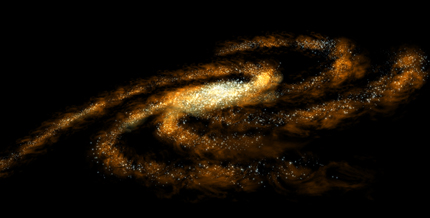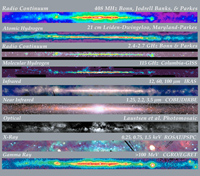Translated in 


We are but a small star within a vast island of
stars called a
galaxy- which is also a small object
in a vast group of galaxies which is in turn part of
the
Universe.
If we live in a dark enough area, we can see
stretched across the sky
a band of clouds:

The image above - a screen grab from
TheSky
version 6 - demonstrates what this might look like.
In ancient times, this was called a river of milk,
spilled by the gods. The name of this feature would
then be called the Milky Way - and the name stuck.
The Milky Way is actually a
galaxy - a system of
billions of
stars gathered by mutual
gravitation.
Our knowledge of our galaxy (and many others) is
still very new but much progress has been made. By
using
radio observations, we were able to determine
the structure of our galaxy (by using
Doppler
Shift).

Based on these types of
observations, we are able to create an artist's
impression, like the one above, for what our galaxy
might look. These illustrations demonstrate our
current understanding of our own Milky Way:
Since the Milky Way is considered an
"average"
galaxy, much of what we learn can be
directly applied to other
galaxies. What we know
about our galaxy:
-
Contains billions of
stars, with
distinct populations
-
Surrounding the galaxy is a
large Halo that contains
Dark Matter,
Globular
Clusters and some
Population II Stars
-
The Disk of the galaxy contains
HII Clouds (molecular hydrogen), the Thick Disk,
and the Thin Disk
-
The Disk of the galaxy contains
new, metal rich stars called
Population I Stars,
and
Open Star Clusters
-
The Bulge and the Halo contain
old, metal poor stars called
Population II Stars
-
There is a spiral structure to
the disk of our galaxy
-
The Bulge of the galaxy contains
the
Galactic Center - believed to be home to a
very massive
black hole called a Supermassive
Black Hole
-
Our galaxy is an "average"
galaxy
-
Our galaxy is probably about 10
billion years old
-
Our Sun is 30,000 light-years to
the
galactic center
-
Our galaxy is 120,000
light-years in diameter
-
Our galaxy rotates at about 220
km/s - but with an unusual rotation curve that
is evidence that
Dark Matter is influencing
rotation (more on
Dark Matter can be found in
the
Cosmology section)
 |
In the diagram above, you may notice we
are located somewhere towards the outer
disk. This does pose a problem as our view
towards the center of our galaxy is blocked
by the HII clouds - or dust. To circumvent
this, we use
Radio Astronomy and
Space-Based
probes to peer deep into the center (as well
as other parts of our galaxy). This image to
the right shows what our galaxy looks like
in a variety of wavelengths. |
Back to Top |

